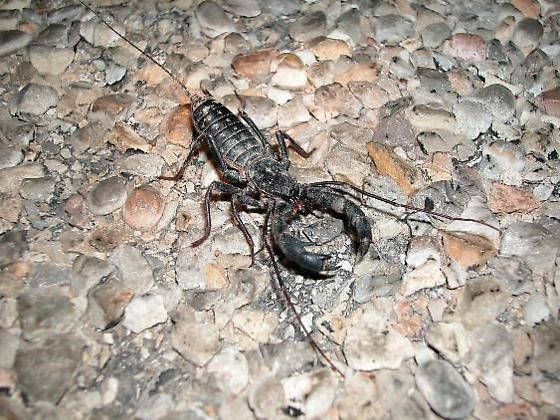Habitat and Geography
Whip scorpions are prevalent all around the world and are commonly
found in the tropics and subtropics, with most in tropical
rainforests (Kern and Mitchell 2011, Hembree 2013). However, Mastigoproctus giganteus whip
scorpions are burrowers which are typically found in dark,
seasonally humid areas like pine forests, grasslands, scrubs, and
barrier islands (Kern and Mitchell 2011). These areas
include dry areas of the southwest US and Mexico like Arizona,
Florida, New Mexico, Oklahoma, and Texas (Schmidt et al. 1999, Kern and Mitchell 2011). This organism is found in specific
areas and is found in one type of habitat with almost no variation.
Interestingly, M. giganteus is in fact the only species of
whip scorpion which is found in the US.
Hembree 2013). However, Mastigoproctus giganteus whip
scorpions are burrowers which are typically found in dark,
seasonally humid areas like pine forests, grasslands, scrubs, and
barrier islands (Kern and Mitchell 2011). These areas
include dry areas of the southwest US and Mexico like Arizona,
Florida, New Mexico, Oklahoma, and Texas (Schmidt et al. 1999, Kern and Mitchell 2011). This organism is found in specific
areas and is found in one type of habitat with almost no variation.
Interestingly, M. giganteus is in fact the only species of
whip scorpion which is found in the US.
These giant
whip scorpions use their massive pedipalps (claws/pincers) to
burrow themselves underneath many things like logs, rocks, and
rotting wood (Hembree 2013). Other places you can find these
creatures are in areas with loose soil, leaf litter, and the
scariest thought is in humid moist corners within buildings. M.
giganteus burrow themselves in well-drained soil during the
driest periods of the year and come up to the surface during May or
June. These creatures will continue to come to the surface during
the night until November while it is the rainy season (Kern
and Mitchell 2011).
Punzo (2006),
from the biology department at the University of Tampa conducted an
observational study where they discovered the shelter selections of
321 M. giganteus species during the daytime. Most (70.4%)
of the whip scorpions they found they discovered in rock crevices.
They also found that 4.4% of the sample size they found under plant
debris, and the remaining 25.2% were found inside of small pre-made
mammal holes. Due to being strictly nocturnal, none were found
outside of their burrows during the day. 66.7% of the shelter
samples found were also in the shade. The depth of M. giganteus
shelters varied from 6.4-39.7 cm and the width of the shelters they
found M. giganteus specimens in was between 0.7-2.9 cm.
Hembree
(2013), conducted an experimental study in which they took 18 whip
scorpions and put them into a controlled environment. Each
environment had a regulated temperature, controlled humidity and set
on a 12 hour light and dark schedule. The object of this experiment
was to get molds of the burrows for observation. Another goal was to
actually see the act of M. giganteus creating their
burrows. They left the whip scorpions in their enclosures for 14-16
days at a time and were randomly checked on to see any changes. What
Hembree observed while examining their burrows was, the M.
giganteus made two types of burrows. There were permanent
burrows which were built with greater care and were more complex.
The other kind of burrow, built with less attention to detail, was
the temporary burrow. The temporary burrows were classified as
burrows which were only in use for less than 72 hours. These
temporary burrows were quickly made and were generally a “J” shape.
The permanent burrows however were deeper, more complex, had bigger
tunnels, more turns and were constantly being modified. In the
beginning of the
 experiment
the top of the soil in each tank was smooth. The experiment showed
the M. giganteus put the extra dirt and soil into piles
which built up to almost 10 cm of added soil around the entrance
hole(s). There were also impressions in the area around the opening
of the burrow from the whip scorpion. The impression marks and
mounds are all due to how it digs and the body structure of the whip
scorpion itself. The whip scorpions were fed crickets during the
experiment which showed the whip scorpion did not only use its
burrow for shelter, but also for hunting. During the
experiment the crickets put into the enclosures for food would enter
the burrow with the whip scorpion waiting to consume the cricket.
The whip scorpion doing this is able to consume its prey without
even leaving its burrow. To find out more about the eating habits
and the interactions with other species of M. giganteus
feel free to visit the Interactions
page.
experiment
the top of the soil in each tank was smooth. The experiment showed
the M. giganteus put the extra dirt and soil into piles
which built up to almost 10 cm of added soil around the entrance
hole(s). There were also impressions in the area around the opening
of the burrow from the whip scorpion. The impression marks and
mounds are all due to how it digs and the body structure of the whip
scorpion itself. The whip scorpions were fed crickets during the
experiment which showed the whip scorpion did not only use its
burrow for shelter, but also for hunting. During the
experiment the crickets put into the enclosures for food would enter
the burrow with the whip scorpion waiting to consume the cricket.
The whip scorpion doing this is able to consume its prey without
even leaving its burrow. To find out more about the eating habits
and the interactions with other species of M. giganteus
feel free to visit the Interactions
page.
Continue to Form and Function
Return to Home
See References